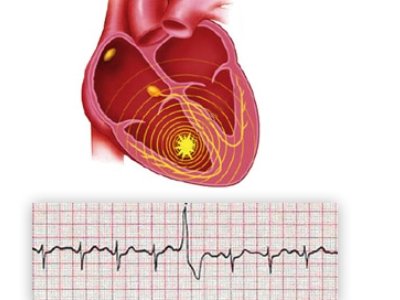What is extrasystole – methods and methods of treatment
Author Ольга Кияница
2017-10-30
Extrasystolia refers to rhythm disturbances, which are formed as a result of the occurrence of extraordinary cuts. In 70% of cases, it is determined in clinically healthy people who do not complain about any rhythm disorders. Often has a favorable course, in the absence of hemodynamic disorders does not lead to serious complications.
In healthy people, up to 200 extrasystoles may occur per day, which are provoked by the reception of strong coffee, black tea, exercise, emotional stress. Such extrasystoles are called functional
In most cases, the extrasystole is determined suddenly, when recording electrocardiography. The development of the disease can be preceded by allergic reactions, intoxications against the background of infection, thyroid hyperfunction, poisoning, neoplastic mechanisms of action.
Video Extrasystoles
What is this extrasystoles in the heart?
Extrasystoles arise due to extraordinary cuts, which make the heart work less effective, because of what various organs and tissues, especially the brain, can suffer. Depending on the localization of the pathological focus, extrasystoles are ventricular, atrial, atrioventricular and sinus when premature impulses come from the sinus node.
Extrasystoles can come from one source and several. Accordingly, monotopic and polytopic extrasystoles are distinguished, among which the latter form of arrhythmia is considered less favorable.
When considering the electrocardiogram, the frequency of the occurrence of extraordinary cuts is noted. If less than 30 extrasystoles are recorded per hour, then they say a rare pathology. More than 30 extrasystoles per hour - a frequent rhythm disturbance. Also on ECG are determined early extraordinary contractions and unstable paroxysmal tachycardia, which on the ECG is characterized by several extrasystoles, which follow one another.
How to treat extrasystoles
Before the beginning of treatment it is necessary to find out whether there are indications, expressed as follows:
- ECG shows frequent, polymorphic extrasystoles, which cause serious disruption of the cardiovascular system;
- the patient is severely suffering from attacks of extrasystole, accompanied by the development of a characteristic clinic (weakness, sensation of cardiac fading, pallor of the skin, increased sweating, etc.);
- with dynamic observation of the patient, a decrease in the ejection fraction is noted, and signs of dilatation of the left ventricle appear.
In the absence of the above indications, drug therapy is not performed.
It is enough to adjust the way of life, eat right, give up bad habits, regularly undergo examinations with the cardiologist, so that a slight extrasystole ceases to disturb at all.
In addition, it is important to eliminate the possible cause of development of extrasystole, which often occurs against the background of the following diseases:
- osteochondrosis;
- alcohol poisoning;
- violation of electrolyte balance, especially extrasystole contributes to a lack of potassium;
- neuroses and neurosis-like conditions;
- dysfunction of the endocrine organs, in particular the thyroid gland.
In the absence of a medicinal effect on the underlying disease, extrasystole therapy may not be effective.
The main tactics of antiarrhythmic therapy:
In general, antiarrhythmic drugs are used, which are taken strictly according to the doctor's prescription. Otherwise, serious side effects may occur.
The main tactics of antiarrhythmic therapy:
- When determining the patient's organic heart diseases, sotalol, cordarone, beta-adrenoblockers are often prescribed.
- In the absence of organic pathology of the heart, use of propafenone, etatsizin and other drugs from the first class of arrhythmics. In severe cases, they can be combined with cordarone and sotalol.
Evaluation of the effectiveness of antiarrhythmic treatment:
- the patient feels better;
- there is no feeling of disruption of the heart.
Antiarrhythmic drugs are not prescribed for the combination of extrasystole and bradycardia. In such cases, eufillin, pindolol is used. Depending on the severity of the clinic, holinolytics or sympathomimetics may be used, but necessarily at the prescription of a physician.
In the absence of results from the conduct of drug and non-pharmacological treatments, radiofrequency ablation is performed. In most cases, it is effective, but complications are also possible. For their prevention it is important to adhere to medical recommendations, in some cases it is necessary after the operation to take antiarrhythmic drugs. More detailed information on the RFA is provided by the attending physician.
Similar articles

It is important to diagnose a variety of arrhythmias, which leads to untimely reduction of ventricles. The signal for extraordinary depolarization comes from an additional (ectopic) focal point of excitation. To prevent the development of serious complications, it is necessary to conduct timely treatment of ventricular extrasystoles.

The rhythm of cardiac activity, in which occasionally there are untimely contractions of the entire heart, or its separate cells. It is detected in 70% of people. Without clinical manifestations, no specific treatment is required. In other cases, it is preceded by the appearance of paroxysms, which cause an attack of a malfunction of the heart. Then it manifests itself as symptoms of the underlying disease.

Of all the species of extrasystole, the most unfavorable is the frequent and polytopian extrasystole. It is determined by means of a special instrumental study, first of all electrocardiograms. After setting the exact diagnosis, treatment is prescribed. In the absence and presence of concomitant organic pathology of the heart, serious complications may develop.
